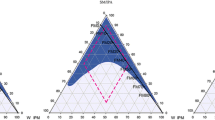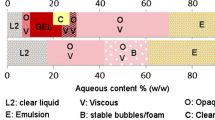Abstract
The performance of dioctyl sodium sulfosuccinate (aerosol OT) in the development of a pharmaceutically acceptable, stable, self-emulsifying water continuous microemulsion with high dilution efficiency was assessed. A pseudoternary microemulsion system was constructed using aerosol OT/medium-chain triglycerides with oleic acid/glycerol monooleate and water. The model microemulsion was characterized with regard to its electroconductive behavior, eosin sodium absorption, interfacial tension, and droplet size measurements after dilution with water. The percolation transition law, which makes it possible to determine the percolation threshold and to identify bicontinuous structures, was applied to the system. The interfacial tension changes associated with the microemulsion formation revealed ultralow values up to 30% oil at a surfactant/cosurfactant ratio of 3∶1. Moreover, the investigated particle size and polydispersity using photon correlation spectroscopy after dilution with excess of the continuous phase proved the efficiency of the microemulsion system as a drug carrier that ensures an infinitely dilutable, homogeneous, and thermodynamically stable system.
Similar content being viewed by others
References
Bourrel M, Schechter RS. The R ratio. In: Bourrel M, Schechter RS, eds. Microemulsions and Related Systems, New York, NY: Marcel Dekker, 1988:1–30.
Constantinides PP, Scalart JP, Lancaster C, et al. Formulation and intestinal absorption enhancement evaluation of water in oil microemulsion incorporating medium chain glycerides. Pharm Res. 1994;11(10):1385–1390.
Beskid G, Unowsky J, Behl CR, et al. Enteral, oral and rectal absorption of ceftriaxone using glyceride enhancers. Chemotherapy. 1988;84:77–84.
Plain KJ, Phillips AJ, Ning A. The oral absorption of cefoxitin from oil and emulsion vesicles in rats. Int J Pharm. 1986;33:99–104.
Hauser B, Meinzer A, Posanski U, Richter F. Cyclosporin emulsion composition. GB patent application 2 222 770. March 21, 1990.
Engel RH, Riggi SJ. Intestinal absorption of heparin facilitated by sulfated or sulfonated surfactants. J Pharm Sci. 1969;58(6):706–709.
Khalafallah N, Gouda MW, Khalil SA. Effect of surfactants on absorption through membranes, IV: effects of dioctyl sodium sulfosuccinate on absorption of a poorly absorbable drug, phenolsulfonphthalein, in human. J Pharm Sci. 1975;64:991–994.
Osborne DW, Ward AJI, O Neill KJ. Microemulsions as topical drug delivery vehicles: in vitro transdermal studies of a model hydrophilic drug. J Pharm Pharmacol. 1991;43:451–454.
Osborne DW, Ward AJI, O Neill KJ. Microemulsions as topical drug delivery vehicles, I: characterization of a model system. Drug Dev Ind Pharm. 1988;14(9):1203–1219.
Trotta M, Gasco MR, Morel S. Release of drugs from oilwater microemulsions. J Control Release. 1989;10:237–243.
Constantinides PP. Microemulsions comprising therapeutic peptides. PCT patent wo 94/19001. September 1, 1994.
Ogiso T, Shintani M. Mechanism for the enhancement effect of fatty acids on the percutaneous absorption of propranolol. J Pharm Sci. 1990;79:1065–1071.
Cooper ER. Increased skin permeability for lipophilic molecules. J Pharm Sci. 1984;73:1153–1156.
Charman WNA, Stella VJ. Effects of lipid class and lipid vehicle volume on the intestinal lymphatic transport of DDT. Int J Pharm. 1986;33:165–172.
Gowan WG, Stavchansky S. The effect of solvent composition upon the blood and lymph levels of phenytoin in rats after gastric administration. Int J Pharm. 1986;28:193–199.
Aboofazeli R, Lawrence MJ. Investigations into the formation and characterization of phospholipid microemulsions, II: psedoternary phase diagrams of systems containing water-lecithiisopropyl myristate and alcohol: influence of purity of lecithin. Int J Pharm. 1994;106:51–61.
Clausse M, Nicolas Morgantini L, Zradba A, Touraud D. Water/ionic surfactant/alkanol/hydrocarbon system. In: Rosano HL, Clausse M, eds. Microemulsion Systems. New York, NY: Marcel Dekker, 1987:15–63.
Clausse M, Nicolas Morgantini L, Zradba A. Water/sodium dodecylsulfate/1-pentanol/N-dodecane microemulsions. In: Rosano HL, Clausse M, eds. Microemulsion Systems. New York, NY: Marcel Dekker, 1987:387–425.
John CH. Microemulsions. In: Surfactant Aggregation., New York, NY: Blackie, Chapman and Hall; 1992:227–230.
Prince LM. Microemulsion? A Technical Explanation. In: Microemulsions: Theory and Practice. New York, NY: Academic Press; 1977:51–56.
Lu JR, Thomas RK, Binks BP, Fletcher PDI, Penfold J. Structure and composition of dodecane layers spread on aqueous solutions of dodecyl- and hexadecyltrimethylammonium bromides by neutron reflection. J Phys Chem. 1995;99:4113–4123.
Baker RC, Florence AT, Ottewill RH, Tadros THF. Investigations into the formation and characterization of microemulsions II Light scattering, conductivity and viscosity studies of microemulsions. J Colloid Interface Sci. 1984;100:332–349.
Carlfors J, Blute I, Schmidt V. Lidocaine in microemulsions: a dermal delivery system. J Dispers Sci Technol. 1991;12:467–482.
Kirkpatrick S. Percolation and conduction. Rev Mod Phys. 1973;45:574–588.
De Gennes PG. La percolation: un concept unificateur. Recherche. 1976;72:919–927.
Lagües M, Sauterey C. Percolation transition in water in oil microemulsions: electrical conductivity measurements. J Phys Chem. 1980;84:3503–3508.
Safran SA, Grest GS, Bug ALM, Webma I. Percolation in interacting systems. In: Rosano HL, Clausse M, eds. Microemulsion Systems. New York, NY: Marcel Dekker; 1987;235–245.
Saski W, Shah SG. Availability of drugs in the presence of surface active agents: critical micelle concentrations of some oxyethylene-oxypropylene polymers. J Pharm Sci. 1965;54:71–74.
Becher P. Nonionic surface active compounds, VI: determination of critical micelle concentration by a spectral dye method. J Phys Chem. 1962;66:374–378.
Ingo S, Sigrid K. Poloxamer systems as potential ophthalmics, II: microemulsions. Eur J Pharm Biopharm. 1993;39(1):25–30.
Schulman JH, Stoeckenius W, Prince LM. Mechanism of formation and structure of microemulsions by electron microscopy. J Phys Chem. 1959;63:1677–1680.
Satra C, Thomas M, Lawrence MJ. The solubility of testosterone in oil in water microemulsions. J Pharm Pharmacol. 1995;47:1126.
Bellocq AM, Bourbon D, Lemanceau B. Three dimensional phase diagrams and interfacial tensions of the water-dodecanepentanol-sodium octylbenzene sulfonate system. J Colloid Interface Sci. 1981;79:419–431.
Aveyard R, Binks BP, Fletcher PDI, MacNab JR. Interaction of alkanes with monolayers of nonionic surfactants. Langmuir. 1995;11:2515–2524.
Meinzer A, Müller E, Vonderscher J. Perorale mikroemulsions formulierung—Sandimmun Optoral/Neoral. In: Müller RH, Hildebrand GE, eds. Pharmazeutische Technologie: Moderne Arzneiformen. Stüttgart, Germany: Wissenschaftliche Verlagsgesellschaft; 1997;117:169–177.
Trotta M, Gasco MR, Pattarino F. Effect of alcohol cosurfactants on the diffusion coefficients of microemulsions by light scattering. J Dispers Sci Tech. 1989;10:15–32.
Trotta M, Gasco MR, Pattarino F. Diffusion of steroid hormones from o/w microemulsions: influence of the cosurfactant. Acta Pharm Technol. 1990;36(4):226–231.
Author information
Authors and Affiliations
Corresponding author
Rights and permissions
About this article
Cite this article
El-Laithy, H.M. Preparation and physicochemical characterization of dioctyl sodium sulfosuccinate (aerosol OT) microemulsion for oral drug delivery. AAPS PharmSciTech 4, 11 (2003). https://doi.org/10.1208/pt040111
Received:
Accepted:
DOI: https://doi.org/10.1208/pt040111




